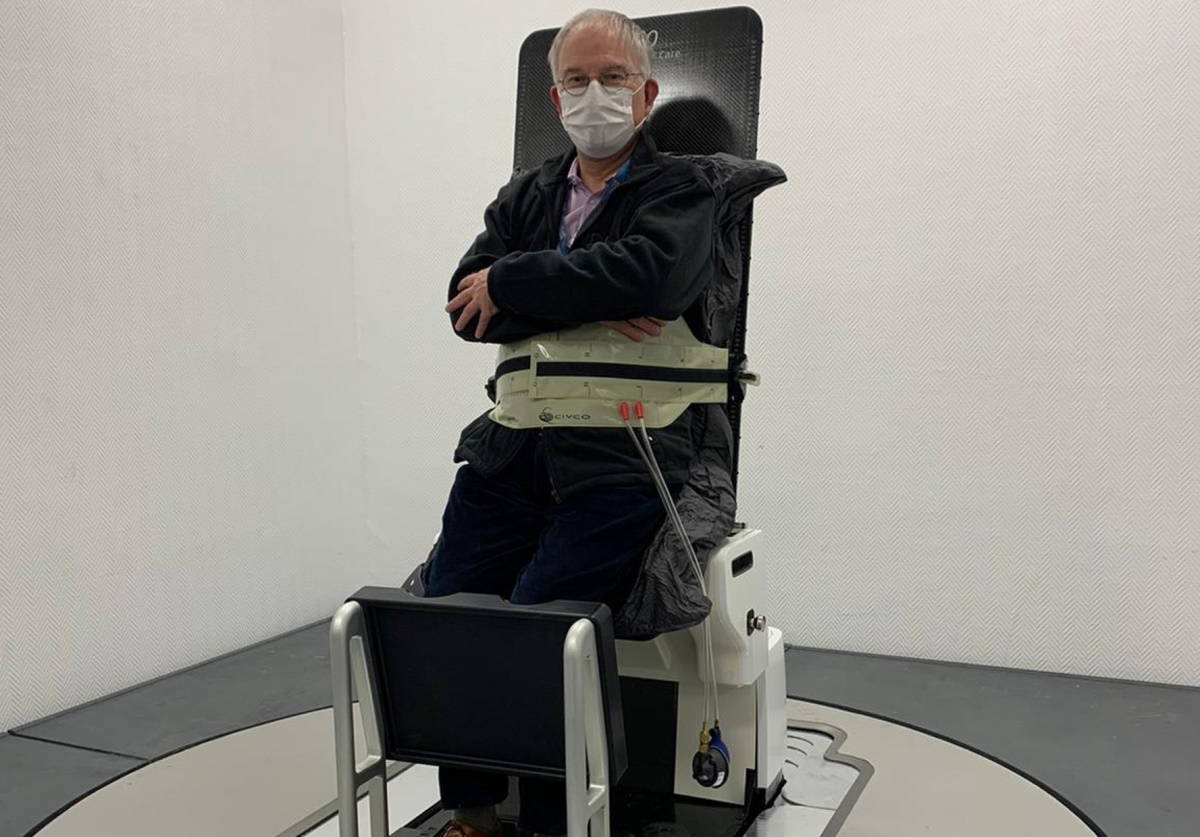
Cancer patients typically lie in a supine position (on their back) during radiotherapy. But for some malignancies, including thoracic, pelvic and head-and-neck tumours, upright body positioning may improve treatment delivery and possibly patient outcome. Upright treatments could increase tumour exposure, reduce radiation dose to adjacent healthy tissue and make breath holds easier for some patients.
To perform upright radiotherapy safely, however, patient immobilization is critical. With this in mind, researchers at the Centre Léon Bérard in France evaluated a patient positioning system currently in commercial development by Leo Cancer Care. The team assessed the immobilization accuracy, set-up time and comfort of the system for 16 patients undergoing radiotherapy for pelvic cancer (prostate, bladder, rectal, endometrial and cervix/uterine tumours).
Findings of the pilot study, reported in Technical Innovations & Patient Support in Radiation Oncology, are encouraging. Initial patient set-up took 4 to 6 min when performed by two radiation therapy technologists working together, and subsequent positionings took between 2 and 5 min. Inter-fraction repositioning was achieved with below 1 mm accuracy on average, and intra-fraction motion over 20 min was within 3 mm for more than 90% of patients. Most patients reported that upright positioning was as good as, and in some cases better than, the supine position that they had to maintain during their standard radiation treatment.
The positioning system (known as “the chair”) is designed to place the patient in appropriate postures according to the cancer type being treated. For prostate and pelvic treatments, patients are perched on the chair, supported by the back of the thigh and a knee rest. Patients are seated vertically for head-and-neck treatments, seated leaning slightly backward for lung and liver radiotherapy, and slightly forward for breast radiotherapy.
The chair itself comprises a seat, a backrest with arm support, a shin rest and a heel stop, all of which adjust to different positions and angles. The chair can rotate at a speed of one rotation per minute, and can simultaneously move in the cranio-caudal direction (vertically in this set-up) by up to 70 cm, allowing the generation of helical movement.
The system incorporates an optical guidance and tracking system, comprising up to five high-resolution cameras. In this study, each patient had their own custom-moulded vacuum cushion and a belt was positioned on the upper part of their abdomen.
For the study, participants undergoing conventional radiotherapy had three additional appointments during their scheduled treatment course to test the upright positioning device. Patients were repositioned at the second and third appointments and the researchers verified the repositioning accuracy using the optical image reference system. They note that image registration was performed using the skin surface, with no skin tattoos or landmarks needed. After being accurately positioned, patients underwent a simulated treatment session with several helical movements lasting 20 min.
Principal investigator Vincent Grégoire and his colleague Sophie Boisbouvier calculated the inter-fraction position shifts after manual registration between reference images and images taken during the repositioning. They report that the chair provided accurate repositioning, with average inter-fraction shifts of –0.5, –0.4 and –0.9 mm in the x-, y– and z-directions, respectively.
The researchers also monitored intra-fraction motion during the chair movements, performing positioning checks every 4 min. After 20 min, the mean intra-fraction shifts were 0.0, 0.2 and 0.0 mm in the x-, y– and z-directions, respectively. Only 10% of patients had inter-fraction shifts exceeding 3 mm and intra-fraction motion exceeding 2 mm. The majority of patients reported that that they were more comfortable in the upright versus the supine position. All patients said that they could breathe comfortably when upright.
The study revealed some modifications required for the chair, including redesigning the belt to improve patient comfort and improvements regarding head positioning. The researchers intend to investigate a new backrest that has been optimally designed to position the head and neck. They also plan to conduct similar assessments of patient immobilization for head-and-neck, lung, breast and upper-abdomen tumours.

Upright treatment could increase patient comfort, reduce proton therapy costs
Grégoire advises that the team plan to compare upright with supine positioning in terms of internal positioning and motion for the tumour types they have investigated. They also will perform in silico dose distribution comparisons between patients in supine and upright positioning, for both photons and protons. They also hope to estimate potential gains in terms of normal tissue complication probability (NTCP) and tumour cure probability (TCP).
The Centre Léon Bérard is a research partner of Leo Cancer Care, which is developing a range of upright radiotherapy products. In addition to the positioning system, these include a vertical diagnostic CT scanner and a 6 MV horizontal-beam linear accelerator to deliver rotational image-guided intensity-modulated radiotherapy. After French government regulatory authorities authorize the importing of the CT scanner, which does not yet have a CE Mark, the team plans to include vertical CT imaging in future research.
